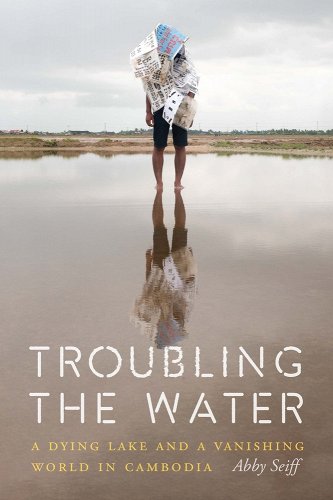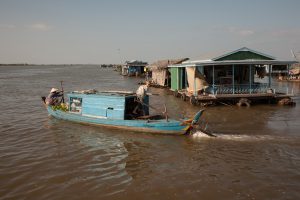Cambodia’s Great Lake – the Tonle Sap – is in trouble. The lake and its residents face the converging impacts of global climate change, upstream hydropower dams, and illegal fishing abetted by government corruption. All have combined to threaten the lake’s nourishing flood-pulse, which for centuries has sustained the world’s largest inland fishery and provided Cambodians with their primary source of protein.
In a new book, “Troubling the Water: A Dying Lake and a Vanishing World in Cambodia,” based on years of reporting around the Tonle Sap, writer and journalist Abby Seiff examines the “perfect storm” of challenges facing the lake and those that dwell on and around its waters. She spoke with The Diplomat about the unique ecology of the Great Lake and whether there is any hope of its long-term survival.
For centuries, detailed descriptions to the Tonle Sap have filled the reports and journals penned by foreign visitors to Cambodia. Can you describe what has prompted this attention? What is unique about Cambodia’s “Great Lake”?
When you look back at these historical, outsider descriptions – whether we’re talking about the Chinese emissary Zhou Daguan in the 1290s, or the French polymath George Groslier in the 1920s – there’s invariably a real sense of awe at the sheer size of the lake and the amount of fish. I think in the book I used the word breathless, and that’s the tone of so many of these accounts. Whether these visitors are accessing the lake on foot or by boat, via the Tonle Sap river, there’s inevitably a moment when the lake unfurls before them and it’s like an ocean: just absolutely massive.
And then of course the second aspect is the fisheries. They’re talking about fish as big as whales, and fish that are so abundant people just walk to the bank and scoop out their dinner with a wicker basket. There’s too many species to name, not just of fish but of birds and crocodiles and turtles and so forth. And then, of course, looming over all of this is the “double movement” of the lake, as the French colonial explorer Lieutenant Jules Marcel Brossard de Corbigny put it. The lake expands and contracts with the seasons and they’re witnessing the movement that happens with that; banks overflowing, trees being submerged by the water, whole floating villages following the water. Who couldn’t be stunned by all of this?
Your book goes into a lot of detail about the Tonle Sap’s importance to those who live on and around its waters. Can you expand a bit on the lake’s economic and social importance? How many people rely on the expanding and contracting waters of the Tonle Sap?
I’ve struggled to find reliable data on how many people, precisely, live on and around the lake and owe their livelihoods to the lake. There’s figures out there ranging anywhere from 1 to 4 million, to just “millions.” So, unfortunately, I think it’s hard to be too specific on this question. What’s clear, though, is that a significant portion of Cambodia’s population (16.7 million) directly relies on the lake, and an even bigger portion relying indirectly. We have to remember, the lake plays a critical role not just for fish, but for rice. A large part of the country’s rice is grown on the Tonle Sap floodplain, and farmers around the lake are reporting steeply dropping yields as the water levels stay low.
And then we’re seeing drops in freshwater fish yield as well. Those who rely on the lake indirectly are not, as of yet, seeing the impacts of that in large part due to fish farms (which come with their own issues, but which are now yielding about the same amount of catch – around half a million tons a year.) But those who rely on the lake directly are just facing absolute devastation. These are people who are already among the poorest and most vulnerable – particularly those living in floating villages – and now many are reporting that they can’t even catch enough to feed their family, let alone to sell and have some income. So this is very destabilizing and leading to high rates of indebtedness, high rates of young people migrating for work, and all the knock-on effects that come with extreme poverty.
 Your descriptions of the lake and its denizens are shot through with a sense of melancholy, due to the fact that age-old social and ecological rhythms are being disturbed by climate change, corruption, and upstream hydropower developments. Briefly, how have these changes impacted the lake and those that dwell on them?
Your descriptions of the lake and its denizens are shot through with a sense of melancholy, due to the fact that age-old social and ecological rhythms are being disturbed by climate change, corruption, and upstream hydropower developments. Briefly, how have these changes impacted the lake and those that dwell on them?
For those who live on the lake it just seems like this perfect storm. I think of it as a local, regional, and global problem. There’s been a string of extremely bad drought years, back-to-back-to-back, which leads to lower Mekong River water levels and, thus, lower Tonle Sap lake water levels. Then we’ve also got hydropower dams on the Mekong mainstem and its tributaries, which impact fish migration and the flow of nutrient-rich silt – but also change how and when water moves downstream. Lastly, there’s been pretty rapid population growth on and around the lake, putting much more pressure on the fisheries. There’s heaps of illegal fishing going on – large scale, but also small scale with desperate fishers feeling like they have little choice but to use illegal methods (such as small-gauge netting) because otherwise they just can’t catch anything.
What this means for fishers is that they’re catching less fish, smaller fish, and fewer species. I mentioned the historical descriptions earlier, but what’s striking is you don’t have to go nearly so far back for those types of descriptions. Plenty of people I spoke to in their thirties remembered prodigious fishing in their childhoods. And those who were just a bit older, people in their fifties and sixties, spoke about there being so many fish they’d jump into the boat, or could be scooped out of the water with a bowl.
Like much of the lower Mekong basin, the Tonle Sap has been hit hard by climate change, but aside from the broader climate context, how has the Cambodian government approached the Tonle Sap? Have its policies recognized the vital ecological, economic, and cultural role that the lake plays? What does the lake’s fate say about the developmental trajectory of Cambodia as a whole?
The million dollar question! This is a complicated one to answer. On one level, yes, of course the government recognizes the vital role of the lake. It’s very much the pride and joy of the country. In the late 1990s, the lake and its surroundings were designated a UNESCO biosphere reserve, with bird sanctuaries, and Ramsar sites, and various conservation zones within those boundaries. Given the extent of forest clearance around the lake, some of this was probably “too little, too late” (as WWF put it), but it’s certainly an important signal and in some areas – Prek Toal, in particular – it has doubtless helped sustain endangered species.
The bigger issue is, as with many of Cambodia’s protected areas, whether the policies on paper translate to real world enforcement. So, again and again with the lake, we’ve just seen a situation where excellent laws are not always resulting in excellent enforcement. NGOs and residents report plenty of large-scale illegal fishing, but it seems that most of the enforcement is aimed at individual, family fishers. There was an excellent report in VOD recently on the mass deforestation of the protected wetlands surrounding the lake – carried out by local officials and rented to farmers. In December, Prime Minister Hun Sen ordered this land to be seized and reforested. So, that’s been happening at a rapid clip with the ACU reportedly investigating those officials. And of course that’s a great move and very important and certainly worth commending. But this has been going on for years and years quite openly. It’s not the sort of thing one can hide. And now, at the end of the day, it’s going to be these small people – in this case farmers who spent money on the land and the seed and so on – who are paying.
In terms of what we see happening on the Tonle Sap, it’s not that different from what we see in Prey Lang or any other protected area. It’s a rich, natural resource and if powerful people see there’s a way for money to be made from it, they’ll do so. If we’re talking about development trajectory, I think unless these sites are really protected; unless vulnerable people relying on them are given enough support; unless there’s a strong anticorruption effort, it just feels like the situation can’t be much improved.
Amid this concatenation of challenges, are there any reasons to be optimistic for the future of the Tonle Sap?
It’s probably hard to be optimistic, but I don’t know if it’s completely hopeless. Things like the flooded forest crackdown are a step. At a more macro level, the price of solar power is fast dropping which means governments may increasingly think about prioritizing that over hydropower. Cambodia put a moratorium on mainstem dams — perhaps it will do so with tributary dams, too. China is in regular, open dialogue with Lower Mekong nations and has signaled its openness to using its reservoirs to help mitigate downstream drought. At the same time, the micro situation, the fishers directly relying on the fish – it does just seem to get worse year by year and without some sort of major efforts to help them, it’s hard to be too optimistic on their behalf.

































